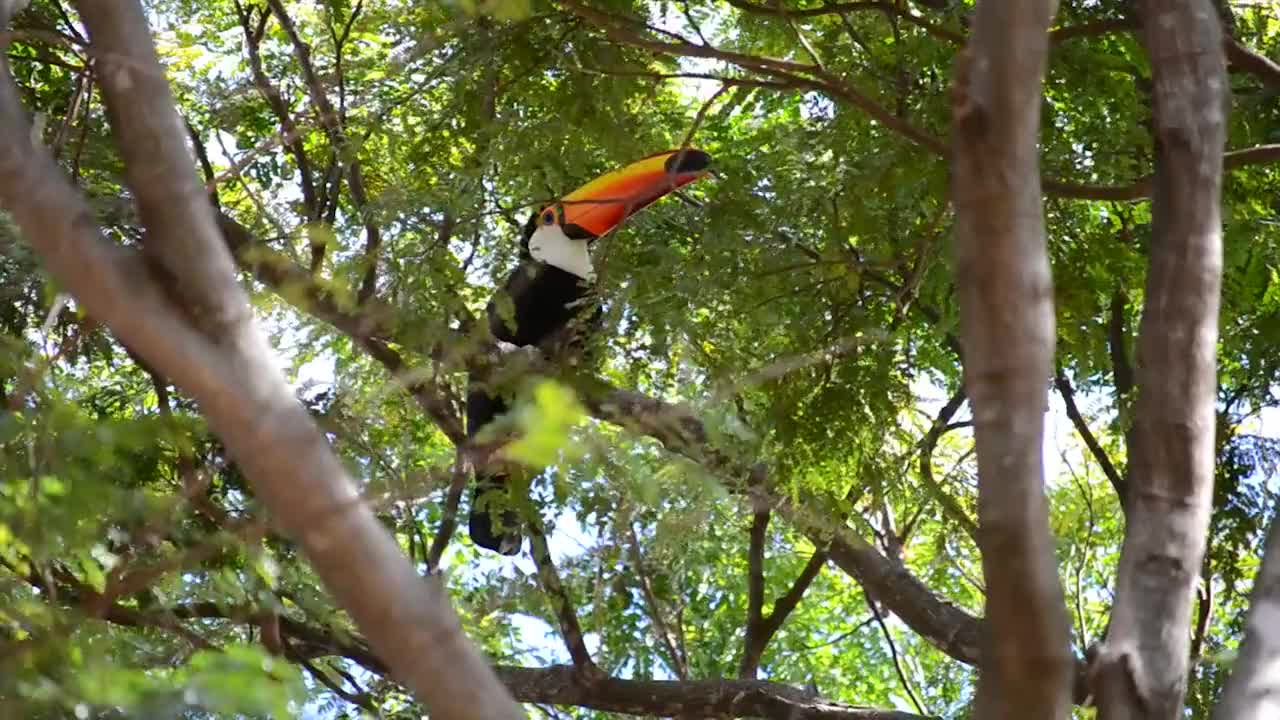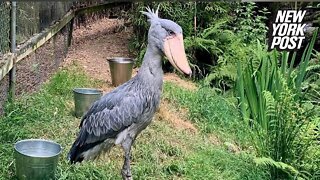Premium Only Content

Orange Horned Toucan Stands Alone Looking For Female Company
Orange Horned Toucan Stands Alone Looking For Female Company , Toucan, (family Ramphastidae), the common name given to numerous species of tropical American forest birds known for their large and strikingly coloured bills. The term toucan—derived from tucano, a native Brazilian term for the bird—is used in the common name of about 15 species (Ramphastos and Andigena), and the aracaris and toucanets are very similar smaller birds of the same family that are also considered toucans, bringing the total number of species to about 35.
The largest toucans, up to 60 cm (24 inches) long, are Ramphastos species. An example common in zoos is the red-breasted (also called green-billed) toucan (R. dicolorus) of Amazonia. Another common zoo resident is the keel-billed toucan (R. sulfuratus), which is about 50 cm (20 inches) long. It is mainly black with lemon yellow on the face, throat, and chest, bright red under the tail, and multicoloured markings on the bill.
Toucan bills can be one-third of the bird’s total length. Though the bill appears unwieldy, even heavy, it is composed of extremely lightweight bone covered with keratin—the same material as human fingernails. The common names of several species, such as the chestnut-mandibled toucan, the fiery-billed aracari, and the yellow-ridged toucan, describe their beaks, which are often brightly coloured in pastel shades of green, red, white, and yellow. This coloration is probably used by the birds for species recognition, as many toucans have similar body patterns and coloration—mainly black with a bold breast colour. The bill is also believed to have a frightening effect on other birds, including hawks. The wings of toucans are short and rounded, and the tail is usually long; these traits, along with the large bill, make toucans ungainly fliers.
In feeding, the toucan obtains food with the saw-edged bill and must toss back its head before swallowing. Although toucans are often considered to be primarily fruit eaters, most species consume a wide variety of food, including insects, snakes, frogs, and occasionally even small mammals. Toucans are also predators on the contents of songbird nests, consuming both eggs and nestlings. In foraging, toucans form large associations of two or more species that search for fruiting trees.
Toucans are among the noisiest of forest birds; their repertoire includes loud barks, bugling calls, and harsh croaks. Larger species perch high in the canopy and utter loud calls that are accompanied by ritualized movements of the head and bill. The vocalizations act as rallying calls that attract groups of birds to good foraging sites. These sounds also seem to function in species recognition, as similar species of toucans that live in the same habitat have unmistakably different calls.
Toucans tend to roost somewhat gregariously in treetop bands. They nest high in tree holes but do not excavate their own cavities. Instead, they find old woodpecker nests or natural holes formed by loss of tree branches. Two to four glossy white eggs are deposited in an unlined cavity, where they are incubated in shifts by both parents. Incubation lasts from 16 days to six weeks or more in some species. The naked hatchlings have large pads on their heels and require at least three weeks before their eyes open. They lack the large bill but grow it nearly to completion during their time in the nest. After about 45 days the nestlings begin life on their own. Family groups may remain together for a long time, as small flocks are often seen throughout the year.
Toucans are nonmigratory, but the mountain toucans (Andigena) move seasonally up and down the Andes Mountains in search of fruit. Like manakins of the forest understory, toucans contribute to the maintenance of tropical forest diversity because they consume and disperse seeds of many plant species.
About 35 species of toucans belonging to six genera constitute the family Ramphastidae, but recent DNA evidence suggests that the New World barbets should also be included in this family. Toucans and barbets are related to woodpeckers; all are piciforms, whose members possess two rearward- and two forward-pointing toes. Although toucans superficially resemble hornbills of the Old World, the two groups are unrelated and belong to different orders.
-
 0:43
0:43
New York Post
2 years agoLonely female shoebill is looking for love
299 -
 0:34
0:34
richardgirard
2 years agoBLOOD ORANGE AMETHYST – Humboldt Seed Company
34 -
 0:51
0:51
Tony Katz
2 years agoLone Romney Stands Alone
19118 -
 44:26
44:26
The Rubin Report
3 hours ago'Real Time' Crowd Stunned by Bill Maher’s Unexpected Glaring Blind Spot
44.2K36 -
 1:45:31
1:45:31
Benny Johnson
3 hours agoDeep State PURGE: CIA Agents STRIPPED of Badges as Trump DISMANTLES Dept of Education | Dem CENSURED
79.6K86 -
 55:56
55:56
Grant Stinchfield
2 hours ago $0.91 earnedWhat Happened to the Mystery Drones? They Don't Just Disappear, or do They?
21.7K3 -
 1:17:41
1:17:41
Flyover Conservatives
13 hours agoThe Medical Industry’s Dark Secret—What They Don’t Want Pregnant Women to Know! - Dr. James Thorp | FOC Show
28.6K1 -
 1:01:32
1:01:32
Standpoint with Gabe Groisman
2 days agoThe War on Israel: Yair Netanyahu Tells All
28.9K9 -
 2:10:19
2:10:19
Steven Crowder
5 hours agoTrump Loves Dictators: Debunking the Left’s Latest Attack Strategy
384K258 -
 1:03:38
1:03:38
Timcast
4 hours agoTrump Eyes CRIMINAL CHARGES For USAID Staff For FRAUD, SCOTUS Under Fire Over Ruling On $2B Payments
78.2K50